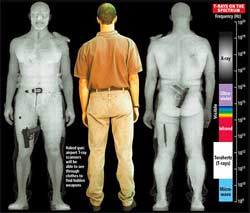Like X-rays let doctors see the bones beneath our skin, "T-rays" could let art historians see murals hidden beneath coats of plaster or paint in centuries-old buildings, University of Michigan engineering researchers say.
T-rays, pulses of terahertz radiation, could also illuminate penciled sketches under paintings on canvas without harming the artwork, the researchers say. Current methods of imaging underdrawings can't detect certain art materials such as graphite or sanguine, a red chalk that some of the masters are believed to have used.
"It's ideal that the method of evaluation for historical artifacts such as frescoes and mural paintings, which are typically an inherent part of a building's infrastructure, be non-destructive, non-invasive, precise and applicable on site. Current technologies may satisfy one or more of these requirements, but we believe our new technique can satisfy all of them," said John Whitaker, an author of the paper who is a research scientist and adjunct professor in the Department of Electrical Engineering and Computer Science at U-M.
Terahertz imaging can reveal depth and detail that other techniques cannot, Whitaker said. And it's not potentially harmful like X-ray imaging because terahertz radiation is non-ionizing. Its rays don't have enough energy to knock electrons off atoms, forming charged particles and causing damage, like X-rays do.
While terahertz radiation is all around us in nature, it has been difficult to produce in a lab because it falls between the capabilities of electronic devices and lasers.
"Terahertz is a strange range in the electromagnetic spectrum because it's quasi-optical. It is light, but it isn't," said Bianca Jackson, first author of the paper who is a doctoral student in applied physics.
The device used for this research is a hybrid between electronics and lasers. It was developed by the Ann-Arbor based company Picometrix. It's called the T-Ray™ system, and it uses pulses from an ultra-fast laser to excite a semiconductor antenna, which in turn emits pulses of terahertz radiation.

